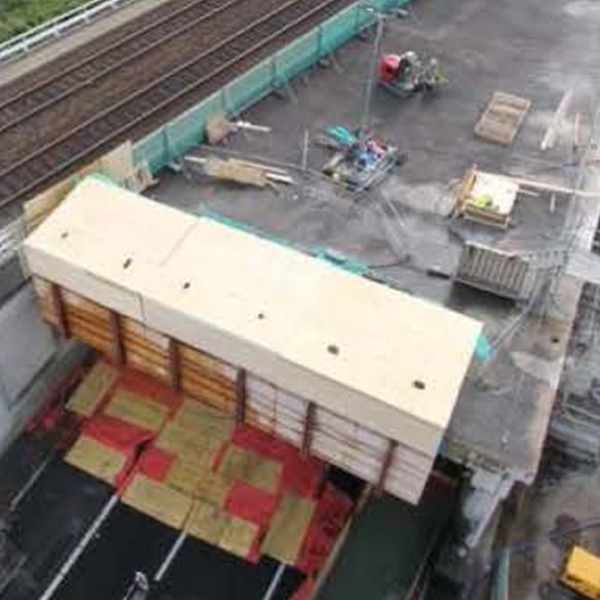Posttensioned cables prove no problem for Hydrodemolition specialist Aqua Demolition Services (ADS) when exposing the steel cables to allow inspection before connecting a new elevated concrete deck and rail tracks in Amsterdam; eliminating the need for up to 10 hand lance operators and saving almost 2 weeks lance operations.
An existing elevated rail decking in Holland presented demolition problems for the contractor BAM Civiel bv in making ready for joining it to a newly constructed concrete deck and new twin rail track.
 Fabricated some 20 years ago in readiness for future expansion, the old reinforced concrete deck – above the busy A10 highway through the southern suburbs of South Amsterdam- included two posttensioned cables.
Fabricated some 20 years ago in readiness for future expansion, the old reinforced concrete deck – above the busy A10 highway through the southern suburbs of South Amsterdam- included two posttensioned cables.
After removing a balustrade/end wall at one end of the old deck, using a conventional concrete wire saw, it was necessary to further remove the deck concrete to expose the rebar for reinstalling to the new adjoining deck. However, a bigger problem was exposing the post-tensioned cables for inspection and recasing in new concrete, without any damage whatsoever to the steel cables and rebar.
Specialist contractor Velsen – Noord-based Aqua Demolition Services (ADS) provided the solution with Hydrodemolition techniques using two Aquajet Systems AQUA CUTTER 710V evolution robots.
“Without using the AQUA CUTTER’s, possibly the only other solution would have been to use hand lances – taking 8-10 operators at least 2 weeks to clear all the specified concrete safely” confided ADS Director, Arjan de Waard.
He continued, “Using Aquajet’s hydrodemolition techniques allowed us to complete the job inside 1 ½ days including set up times.
” The first post tensioned cable was located 50mm below the surface of the 12m wide x 27m long concrete deck.
Comprising some 12 bundles of cable to give a 140mm diameter, the post-tensioned cables were ‘tied` in to a steel plate. Once exposed and inspected, the cables will be re-cased in new concrete and the steel plate removed.
“We were extremely worried about initially removing the concrete as the client, the rail authority O.V. Saal had specified there must be no damage to the steel cables. But the fears proved unwarranted as the AQUA CUTTER’s removed all the concrete cleanly and left the steel cables totally exposed and undamaged” said Bam Civiel Project Manager Leen van Anrooij.
A second, similar sized post-tensioned cable was also located some 600 mm below the first cable.
Access to this one however was close to the elevated deck’s columns and beam above the pile cap and, once again, the client specified no damage to the beam behind the contoured deck.
“We therefore opted to tackle this problem by using a second AQUA CUTTER 710V evolution robot installed with a 7m vertical mast” explained ADS CEO Hans van‘t Geloof.
“Not only did it ease the Hydrodemolition process from the front of the 900m deep deck, it also allowed us to progress at a fast rate and, with no damage to the beam wall.”
Hydrodemolition works by pressurising and widening existing pores and micro-cracks in a concrete structure using high-pressure water penetration.
The rate of removal is dependent on the amount of water directed towards the concrete surface, and consequently the area and depth of removal can be closely controlled. Using a high pressure water jet also makes it easy for the operator to work around obstructions; particularly when compared with, for example, conventional jackhammer methods.
“With hydrodemolition, once programmed the jet moves rapidly and continuously over the selected area for removal,” explained Hans.
“There is no percussive effect on the surface, with the water jet penetrating the deteriorated concrete, and there is no modification of the concrete microstructure or pore structure.
“Apart from very effective cleaning there is also no effect on the rebar.” Both AQUA CUTTER’s, from Swedish specialist manufacturer Aquajet Systems, operated at a pressure of 1040 bar and 261/min of water.
In accordance with all environmental specifications ADS was responsible for bringing to site its own water supply and, using eight 35m³ tanks to remove contaminated water offsite for cleaning treatment. Bam Civiel’s contract was awarded two years ago and has a completion date of 2015.
Comprising a 7km section of the new proposed 18.5km link from Amsterdam South to Duivendrecht, the contract featured laying twin rail tracks both at grade and on seven new elevated bridges alongside the existing rail network. It also includes a station extension at Rai.
The new line is intended to form a vital link in public transport plans between Schiphol and Lelystad aimed at doubling the number of passengers each day to almost 80,000 people by 2020.
It is planned to double the number of trains from 6 to 12 per hour by 2016 and introduce a ‘travelling without timetable` service.
In addition, the new track between Amsterdam South and Utrechtboag will, in addition to improving the service to Schipol, also improve services to Utrecht and beyond.